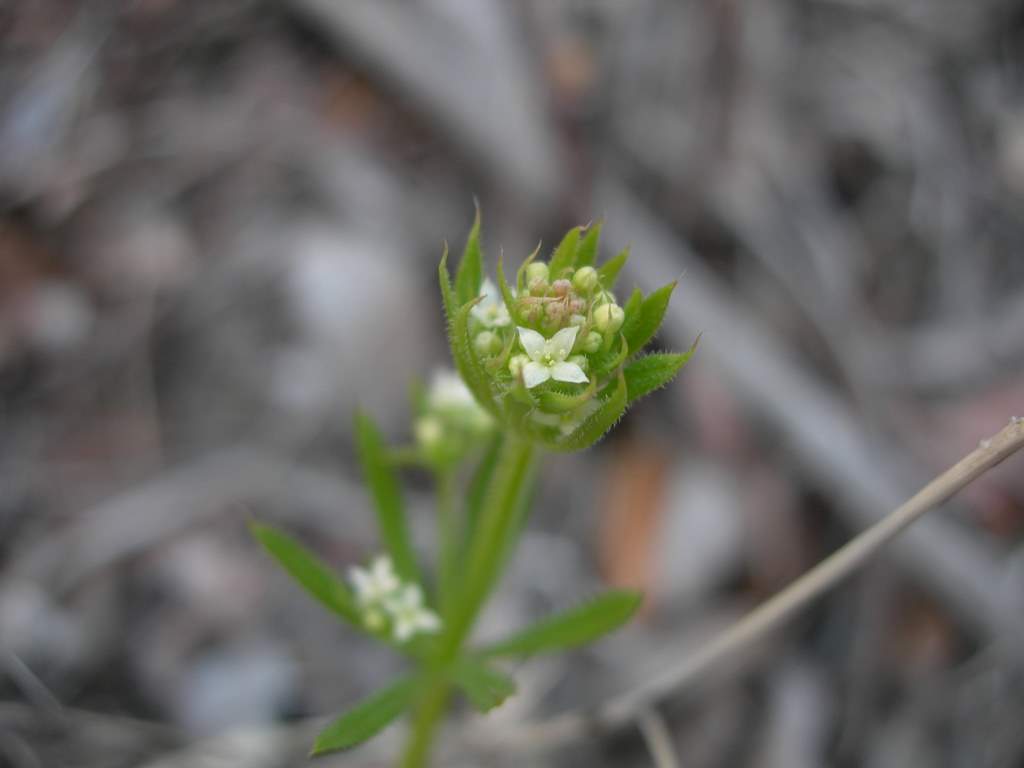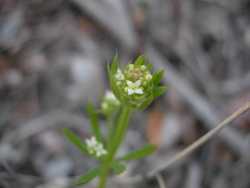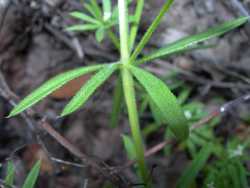Plant: annual herb; very scabrous with retrorse prickly hairs. STEMS 10-90 cm or more long
Leaves: 6-8 at each node, the earliest often spatulate and petiolate, the later ones linear-oblanceolate to oblanceolate, 13-31 mm long, tapering to narrow bases and to mucronate apices
Flowers: perfect, few on well exserted leafy indeterminate lateral branchlets, 1-2 in a cymule or often 1 in an axil; corolla rotate, the lobes obtuse or acute, white or yellowish
Fruit: nutlets, with uncinate, upturned hairs usually shorter than the fruit body
Misc: Moist places; north slopes; in shade of chaparral or forest edges; 600-2200 m (2000-7300 ft); Apr-Sep
REFERENCES: Dempster, Lauramay T. 1995. Rubiaceae. J. Ariz. - Nev. Sci. 29(l): 29.
Annual herb with a short taproot 10 cm - 1 m tall
Leaves: in whorls of six to eight, stalkless, 1 - 8 cm long, to about 1 cm wide, linear to reverse lance-shaped with a bristly tip, one-veined, with bristly, hook-tipped hairs above. The margins and midrib beneath are roughly hairy.
Inflorescence: a branched cluster of one to five flowers growing from a leaf axil.
Flowers: white to greenish white, 1 - 2 mm wide, more or less flat and circular in outline, with four short lobes. Lobes 1.2 mm long and wide, pointed. Stamens four, alternating with lobes, shorter than corolla. Styles two, pale yellow, short.
Fruit: dry, indehiscent, 1.5 - 4 mm wide, spherical, paired, separating when ripe, one-seeded, with hook-tipped bristles.
Stems: multiple from base, weak, more or less scrambling, slender, four-angled, unbranched or sparsely branched, hollow, with short, downward, hooked hairs on the angles.
Similar species: No information at this time.
Flowering: mid-April to mid-June
Habitat and ecology: Very common in woods, sometimes growing in large patches in spring. It also commonly grows as a weed in high-nitrogen areas such as dumps and barnyards.
Occurence in the Chicago region: native
Notes: The common name Cleavers refers to this plants ability to grasp onto clothes and fur with its tiny, hooked prickles.
Etymology: Galium comes from the Greek word gala, meaning milk, referring to the plants that are used to curdle milk. Aparine is the Greek name for this plant.
Author: The Morton Arboretum
Throughout the state in moist woods. It is more common in moist woods and in some places it will form dense stands, especially in alluvial flats; also found along roadsides and sometimes it is an annoying weed in gardens. It is undoubtedly a native of Indiana.
Duration: Annual
Nativity: Native
Lifeform: Vine
General: Slender, scrambling or prostrate annual, very scabrous with retrorse prickly hairs, 50-150 cm long, sometimes stiffer and erect in dry habitats.
Leaves: Whorled with 6-8 at each node, the earliest often spatulate and petiolate, later linear-oblanceolate to oblanceolate, 13-31 mm long, tapering to narrow bases to mucronate apices.
Flowers: Perfect, few on well exserted and leafy indeterminate lateral branchlets, 1-3 flowered cymes, becoming cymose-paniclate in mature plants, sometimes 1 flower in axil; corolla rotate, lobes obtuse or acute, white to yellowish 0.4-0.8 mm long.
Fruits: Nutlets with uncinate, upturned hairs usually shorter than fruit body.
Ecology: Found in moist places, north slopes, intertwined with shrubs, and in canyons from 2,000-7,500 ft (610-2286 m); flowers April-September.
Notes: Distinguished by its being an annual, a vine, and having lanceolate leaves, 6 to a whorl.
Ethnobotany: Used as a laxative, for skin troubles, as a love medicine, it is considered poisonous, used as a horse medicine, an emetic, for kidney trouble, gonorrhea, used as a diuretic, for kidney stones, as a tonic, and as a hair wash.
Etymology: Galium is from the Greek word gala, milk, an allusion to the fact some species are used to curdle milk, while aparine is a Greek name for the plant called cleavers.
Synonyms: Numerous, see Tropicos
Editor: SBuckley, 2010
Annual 1-10 dm, the stems weak, retrorsely hooked-scabrous on the angles, ±scrambling, seldom much branched; lvs in whorls of (6)8, narrow, 1-nerved, cuspidate, 1-8 cm, retrorsely scabro-ciliate on the margins and often also on the midvein beneath, uncinate-hispid above; infls mostly 3-5-fld, on axillary peduncles or in 3's on short branches; cor white, 4-parted, 1-2 mm wide; fr uncinate-hispid, or rarely smooth. Damp ground, usually in shade; circumpolar, and found over most of temperate N. Amer. Plants with relatively large frs (mostly 2.8-4 mm, exclusive of the bristles), and with lvs to 8 cm, said to be mainly tetraploid to octoploid (on x=11) are var. aparine. Plants
with smaller frs (mostly 2-3 mm), and the lvs not over 4 cm, said to have usually 2n=20, but sometimes to 2n=66, are var. echinospermum (Wallr.) Farw. (G. spurium; G. vaillantii)
Gleason, Henry A. & Cronquist, Arthur J. 1991. Manual of vascular plants of northeastern United States and adjacent Canada. lxxv + 910 pp.
©The New York Botanical Garden. All rights reserved. Used by permission.











